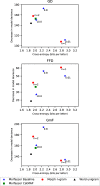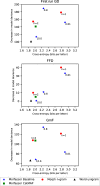Statistical models of morphology predict eye-tracking measures during visual word recognition
- PMID: 31102191
- PMCID: PMC6800854
- DOI: 10.3758/s13421-019-00931-7
Statistical models of morphology predict eye-tracking measures during visual word recognition
Abstract
We studied how statistical models of morphology that are built on different kinds of representational units, i.e., models emphasizing either holistic units or decomposition, perform in predicting human word recognition. More specifically, we studied the predictive power of such models at early vs. late stages of word recognition by using eye-tracking during two tasks. The tasks included a standard lexical decision task and a word recognition task that assumedly places less emphasis on postlexical reanalysis and decision processes. The lexical decision results showed good performance of Morfessor models based on the Minimum Description Length optimization principle. Models which segment words at some morpheme boundaries and keep other boundaries unsegmented performed well both at early and late stages of word recognition, supporting dual- or multiple-route cognitive models of morphological processing. Statistical models based on full forms fared better in late than early measures. The results of the second, multi-word recognition task showed that early and late stages of processing often involve accessing morphological constituents, with the exception of short complex words. Late stages of word recognition additionally involve predicting upcoming morphemes on the basis of previous ones in multimorphemic words. The statistical models based fully on whole words did not fare well in this task. Thus, we assume that the good performance of such models in global measures such as gaze durations or reaction times in lexical decision largely stems from postlexical reanalysis or decision processes. This finding highlights the importance of considering task demands in the study of morphological processing.
Keywords: Eye movements; Lexical processing; Mental models; Psycholinguistics; Word recognition.
Figures




Similar articles
-
Using Statistical Models of Morphology in the Search for Optimal Units of Representation in the Human Mental Lexicon.Cogn Sci. 2018 Apr;42(3):939-973. doi: 10.1111/cogs.12576. Epub 2017 Dec 19. Cogn Sci. 2018. PMID: 29265549
-
Surviving blind decomposition: A distributional analysis of the time-course of complex word recognition.J Exp Psychol Learn Mem Cogn. 2017 Nov;43(11):1793-1820. doi: 10.1037/xlm0000411. Epub 2017 Apr 27. J Exp Psychol Learn Mem Cogn. 2017. PMID: 28447810 Free PMC article.
-
How strongly do word reading times and lexical decision times correlate? Combining data from eye movement corpora and megastudies.Q J Exp Psychol (Hove). 2013;66(3):563-80. doi: 10.1080/17470218.2012.658820. Epub 2012 Apr 24. Q J Exp Psychol (Hove). 2013. PMID: 22524868
-
The Salience of Complex Words and Their Parts: Which Comes First?Front Psychol. 2016 Nov 21;7:1778. doi: 10.3389/fpsyg.2016.01778. eCollection 2016. Front Psychol. 2016. PMID: 27917133 Free PMC article. Review.
-
From decomposition to distributed theories of morphological processing in reading.Psychon Bull Rev. 2022 Oct;29(5):1673-1702. doi: 10.3758/s13423-022-02086-0. Epub 2022 May 20. Psychon Bull Rev. 2022. PMID: 35595965 Review.
Cited by
-
Subword Representations Successfully Decode Brain Responses to Morphologically Complex Written Words.Neurobiol Lang (Camb). 2024 Sep 11;5(4):844-863. doi: 10.1162/nol_a_00149. eCollection 2024. Neurobiol Lang (Camb). 2024. PMID: 39301210 Free PMC article.
References
-
- Akaike H. A new look at the statistical model identification. IEEE Transactions on Automatic Control. 1974;19:716–723.
-
- Andrews S, Miller B, Rayner K. Eye movements and morphological segmentation of compound words: There is a mouse in mousetrap. European Journal of Cognitive Psychology. 2004;16:285–311.
-
- Baayen HR, Milin P, Filipovic DD, Hendrix P, Marelli M. An amorphous model for morphological processing in visual comprehension based on naive discriminative learning. Psychological Review. 2011;118:438–482. - PubMed
-
- Baayen RH, Dijkstra T, Schreuder R. Singulars and plurals in Dutch: Evidence for a parallel dual route model. Journal of Memory and Language. 1997;37:94–117.
-
- Baayen RH, Shaoul C, Willits J, Ramscar M. Comprehension without segmentation: A proof of concept with naive discriminative learning. Language, Cognition and Neuroscience. 2016;31(1):106–128. doi: 10.1080/23273798.2015.1065336. - DOI
Publication types
MeSH terms
LinkOut - more resources
Full Text Sources

